31 Lesson 4A
1. Mirar. Watch the video and learn about the food preferences of Mackenzie, Javier, Allison, and Camila.
Paso 1. Watch the video once, and write down as many foods/drinks as you can remember.
Paso 2. Watch the video one more time, and answer the following questions.
Modelo. ¿Quién prefiere el arroz? Camila prefiere el arroz
- ¿Quiénes prefieren el café?
- ¿Quiénes prefieren la naranja?
- ¿Quién prefiere los camarones?
- ¿Quiénes prefieren las albóndigas?
Paso 3. You want to know some of the preferences of your classmates. Write down 3 questions similar to the ones from the interview, but with different foods/drinks.
Paso 4. Grab your phone, and record your classmate answering the questions you prepared in Paso 3
2. Completar. Let’s learn about the verb “preferir.”
Paso 1. Complete the following chart of the verb “preferir”
| Subject | PREFERIR |
| yo | prefier_ |
| tú | |
| usted/él/ella/elle | |
| nosotros | preferimos |
| vosotros | preferís |
| ustedes/ellos/ellas/elles |
Paso 2. Look at all the conjugations and pay particular attention to the stems. Are they all the same or are there any differences?
Paso 3. Compare the conjugations of the verb “preferir” with the ones of the verb “querer” below. Are there any similarities between the two verb conjugations? Can you write down a general rule?
| Subject | QUERER |
| yo | quiero |
| tú | quieres |
| usted/él/ella/elle | quiere |
| nosotros | queremos |
| vosotros | queréis |
| ustedes/ellos/ellas/elles | quieren |
3. Hacer una lista. You want to prepare a meal for a special event, and you want your roommate’s advice about making a shopping list.
List of possible events: una cena romántica, una fiesta del Super Bowl, el cumpleaños de mi hermano, el aniversario de bodas de mis padres
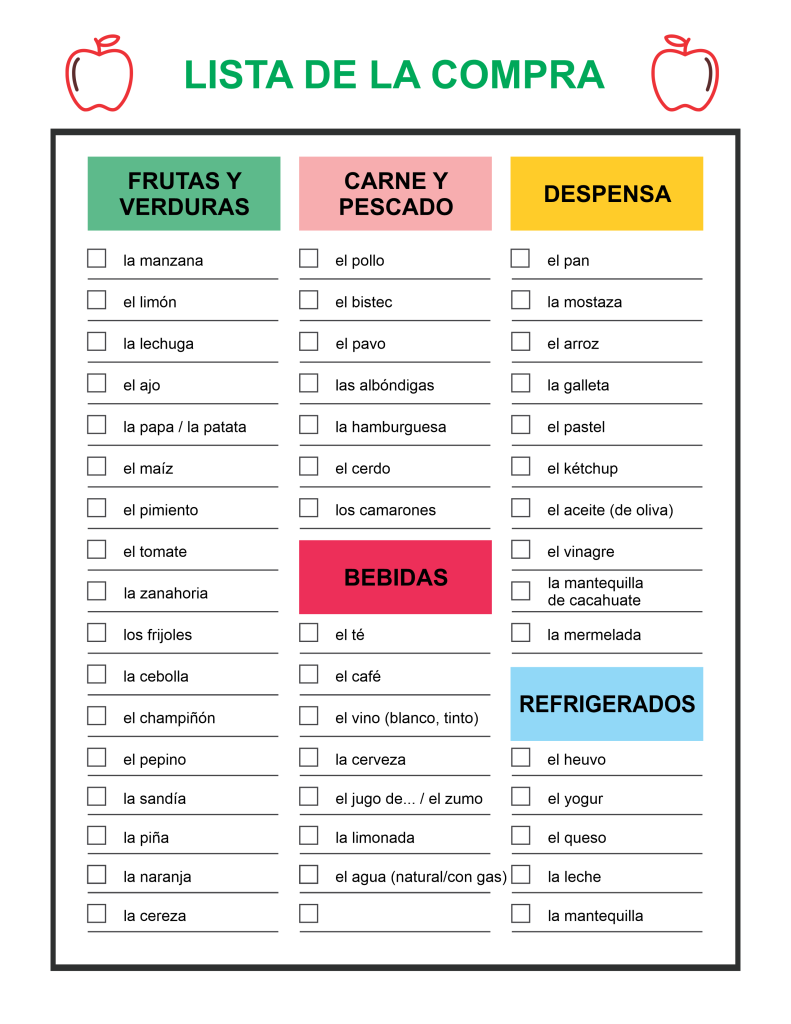
Paso 1. Ask your roommate (compañera de clase) what to buy. Your roommate will look at the Lesson 4A vocabulary list of food and drinks to help you decide. Write down your roommate’s suggested shopping list.
Ojo: When using two verbs together in Spanish, the first verb is conjugated, while the second remains in its infinitive form. For example, in a phrase like “Quiero preparar” (I want to prepare), “quiero” is conjugated to match the subject, and “preparar” stays in the infinitive form.
| Estudiante A | Estudiante B |
| Quiero preparar una cena española. ¿Qué tengo que comprar? | Tienes que comprar huevos, patatas, cebolla, lechuga,… |
| (Write down the list your partner gives you.) |
Paso 2. Select 3 items from the list and ask your roommate where you can buy them.
Modelo:
| Estudiante A | Estudiante B |
| ¿Dónde puedo comprar huevos? | Puedes comprar huevos en Trader Joe’s. |
4. Emparejar. Work with a partner to complete the following activities using expressions with tener.
Paso 1. Take turns asking the following questions, and your partner will provide the most logical response from the bank.
¿Qué haces cuando…
- tienes hambre?
- tienes sed?
- tienes frío?
- tienes calor?
- tienes sueño?
- tienes prisa?
| A. Nado en la piscina. |
| B. Tomo una siesta en el sofá. |
| C. Como una manzana. |
| D. Corro a mis clases. |
| E. Llevo una sudadera. |
| F. Bebo agua. |
Paso 2. Now take turns asking your partner the same questions but you can invent your own answers.
5. Investigar. ¿Cuánto cuesta? You and your roommates decided to prepare a tortilla de patatas (a typical dish from Spain).
Paso 1. Go online, find a recipe for a tortilla de patatas (tortilla española) and write down the ingredients.
Paso 2. Estimate how much you will be paying for each ingredient. If you don’t know, go online and look up the prices from the website of the grocery store you use the most.
Cocinar una tortilla de patatas cuesta $…
Paso 3. How much would it cost if you were in vacation in Chile? Look at the flyer below and estimate the cost.
Cocinar una tortilla de patatas en Chile cuesta $…
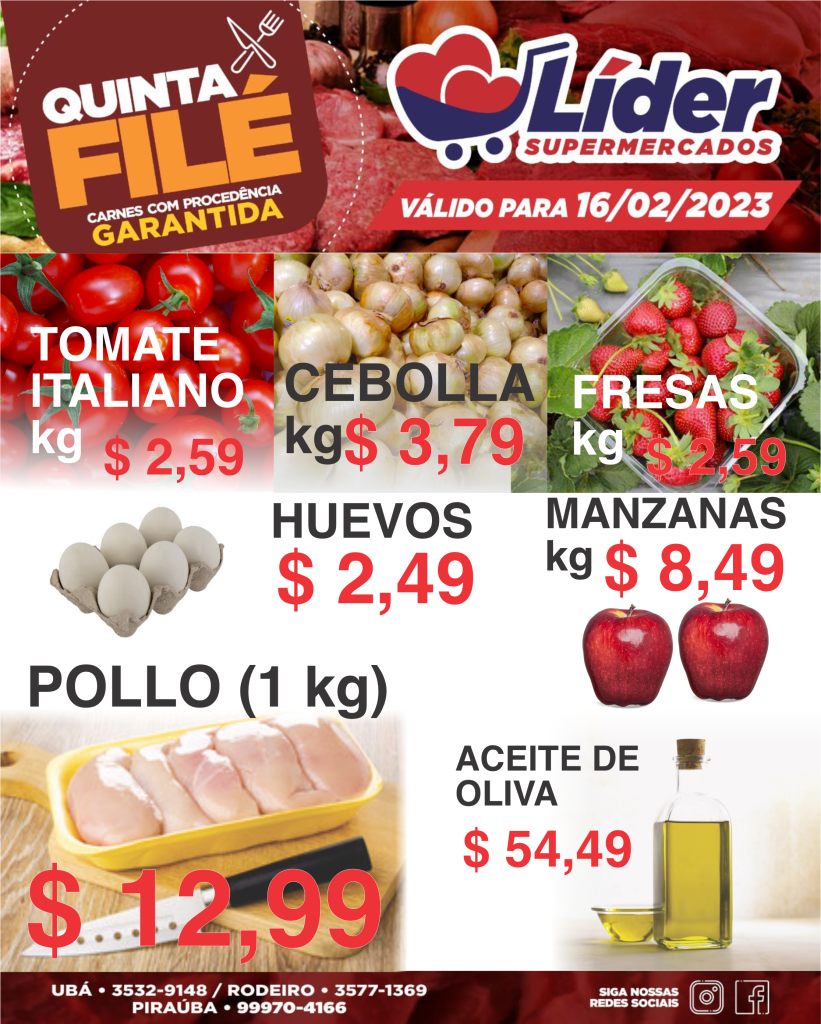
6. Contestar. Miren el video sobre las tapas o pintxos (el nombre para las tapas en Bilbao) y contesten las siguientes preguntas.
- ¿Qué son las tapas? ¿Entre quiénes se comparten (are shared) las tapas?
- ¿Cuáles son dos ejemplos de tapas?
- ¿Cómo se sirven las tapas en algunas regiones de España?
7. Contestar. Miren la receta sobre un pintxo (pincho) de salmón.
Las tapas son un tipo de comida española que consiste en pequeñas porciones de comida que se comparten entre amigos o familiares. Se sirven en bares y restaurantes. Las tapas pueden incluir varias comida, como jamón serrano, croquetas, tortilla española, gambas al ajillo y patatas bravas. En algunas regiones de España, las tapas se sirven gratis con bebidas. Las tapas son una parte importante de la cultura española y son una excelente manera de disfrutar de una variedad de sabores en una sola comida.
Paso 1: Write down a list of all the ingredients needed to prepare una tosta de salmón y txaka.
Paso 2: Answer the following question..
- ¿Quieres probar una tosta de salmón y txaka?
- ¿Cuál es el ingrediente más interesante?
8. Conjugar. Read the following paragraph about meal habits in Spain. Select the appropriate verb and conjugate it. Remember that some of the verbs have stem changes.
En España, muchas personas ______________ (desayunar / subir) algo ligero (ligero) por la mañana, como café con tostadas. Más tarde, ellos ______________ (almorzar / contar) entre las 2 y las 3 de la tarde. Es la comida principal del día. En general, los españoles ______________ (probar / beber) diferentes platos y ______________ (preferir / leer) los restaurantes que les ofrecen (offer them) comida especial. En la noche, los españoles ______________ (cenar / cerrar) algo más ligero que el almuerzo.
9. Decidir. You and your classmates want to plan a class pintxos party. Work in groups of 3-4 to complete the following steps.
Paso 1: Compile a master list of your group members’ favorite foods. You can use the suggestions from the word bank below or add your own ideas.
| Los mariscos | Las papas | La cebolla |
| El pescado | El pan | El ajo |
| El chorizo | Las verduras | Los pimientos |
| El jamón | Los huevos | El champiñón |
| El queso | Las aceitunas | ¿Otras ideas? |
Paso 2: Look at the pintxos pictured below. Carefully read the ingredient lists, and based on your compiled list, select your top three dishes for the pintxos party.
- …
- …
- …
Las opciones para la fiesta:
Tortilla de patata (Huevos, cebolla, patatas y aceite de oliva)
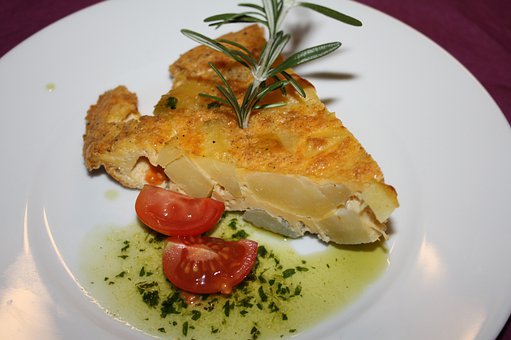
Pintxo de jamón y manchego (Jamón, queso Manchego, pan
y aceite de oliva)
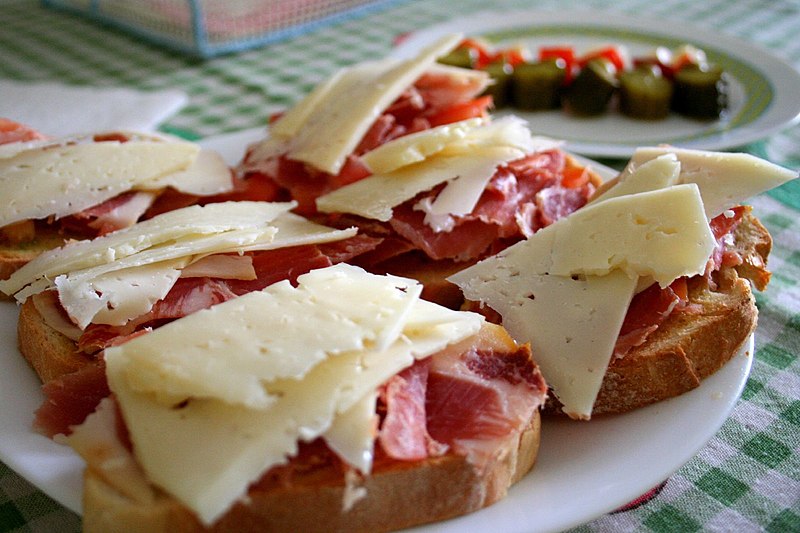
Chorizo y padrón (chorizo y Pimientos de padrón = padrón peppers)
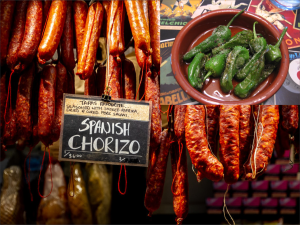
Gilda (Anchoa = anchovies, aceitunas de manzanilla y pimiento de guindilla)
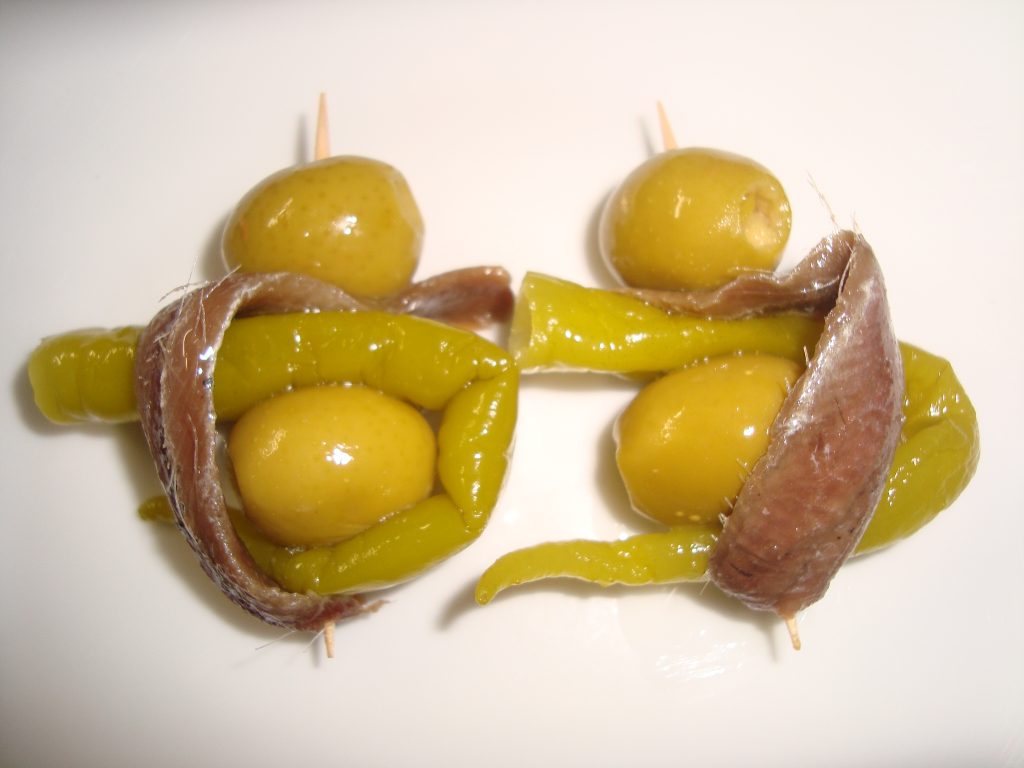
Paso 3: As a class, tally the total numbers to rank the pintxo options. See which three pintxos won the most votes for the party!
10. Emparejar. After looking at all these pictures, you are starting to get hungry.
Paso 1. Match the food and drinks with the appropriate tener expression.
| TENER HAMBRE | TENER SED |
- la piña
- el café
- el jamón
- el té
- el atún
- el agua
- la cerveza
- la galleta
- la limonada
- la uva
Paso 2. Write a short paragraph about everyting you want to eat and drink right now, and share it with a partner.
Tengo hambre. Quiero comer…
11. Adivinar y entrevistar. ¿Conoces bien a tu compañera? Let’s see how well you you know your partner!
Paso 1: Read the questions and select the answers you think your partner is going to say.
| Compañera A | Compañera B |
A) ¿Dónde prefieres comer?
|
A) ¿Con quién prefieres cenar?
|
B) ¿Qué desayunas normalmente?
|
B) ¿Qué prefieres para el postre?
|
C) ¿Qué quieres hacer este fin de semana?
|
C) ¿Cuándo desayunas?
|
D) ¿Qué bebida prefieres?
|
D) ¿Qué preparas para una cena romántica?
|
E) ¿Con qué frecuencia cocinas?
|
E) ¿Qué quieres comer de merienda?
|
4A Know your partner entrevista
Paso 2: Ask your partner the questions to see if you guessed correctly. Be sure to answer your partner’s questions using complete sentences!
Modelo:
| Estudiante A: | Estudiante B: |
| (Asks): ¿Dónde prefieres comer? | (Selects their answer from the options and says): Prefiero comer en la cafetería. |
| Puts a check by the answer if guessed it correctly. |
12. Conjugar. Read the following paragraph about meal times and food choices in Spain. While reading, conjugate the verb in parenthesis according to the subject of the sentences.
13. Comparar. Look at the following chart and think about your eating habits.
Paso 1. Fill out the chart with the dishes you normally eat. Make sure to include the times that you eat your meals.
| Desayuno | Almuerzo | Cena | |
| Hora: |
|
||
| Comida: |
|
||
| Bebida: |
|
Paso 2. Compare your eating habits with a classmate. Do you eat at similar times or different? Are your food and drink choices different or similar and why?
Modelo:
| Estudiante A: | Yo prefiero comer cereal con leche para el desayuno. Normalmente, como a las 8:00. |
| Estudiante B: | ¡Ah! Prefiero comer huevos con patatas y jamón, pero como más tarde a las 10:00. |
14. Escribir. Write a short paragraph comparing your eating habits to the eating habits of a typical Spaniard. Make sure to include words like pero or al contrario/a diferencia de to explain the differences. With a partner, share your paragraph and talk about the differences between US and Spanish eating habits.
15. Conectar. Chile has many traditional dishes, and they are all so delicious.
Paso 1. Match each dish with the corresponding picture.
| maíz | carne | pollo | porotos* | masa |
- El pastel de choclo tiene______________
- La empanada de pino tiene ___________
- La cazuela lleva _____________________
- El charquicán lleva ___________________
- El bistec a lo pobre lleva ______________

